JEEP RENEGADE 2016 1.G Manual Online
Manufacturer: JEEP, Model Year: 2016, Model line: RENEGADE, Model: JEEP RENEGADE 2016 1.GPages: 688, PDF Size: 7.09 MB
Page 81 of 688
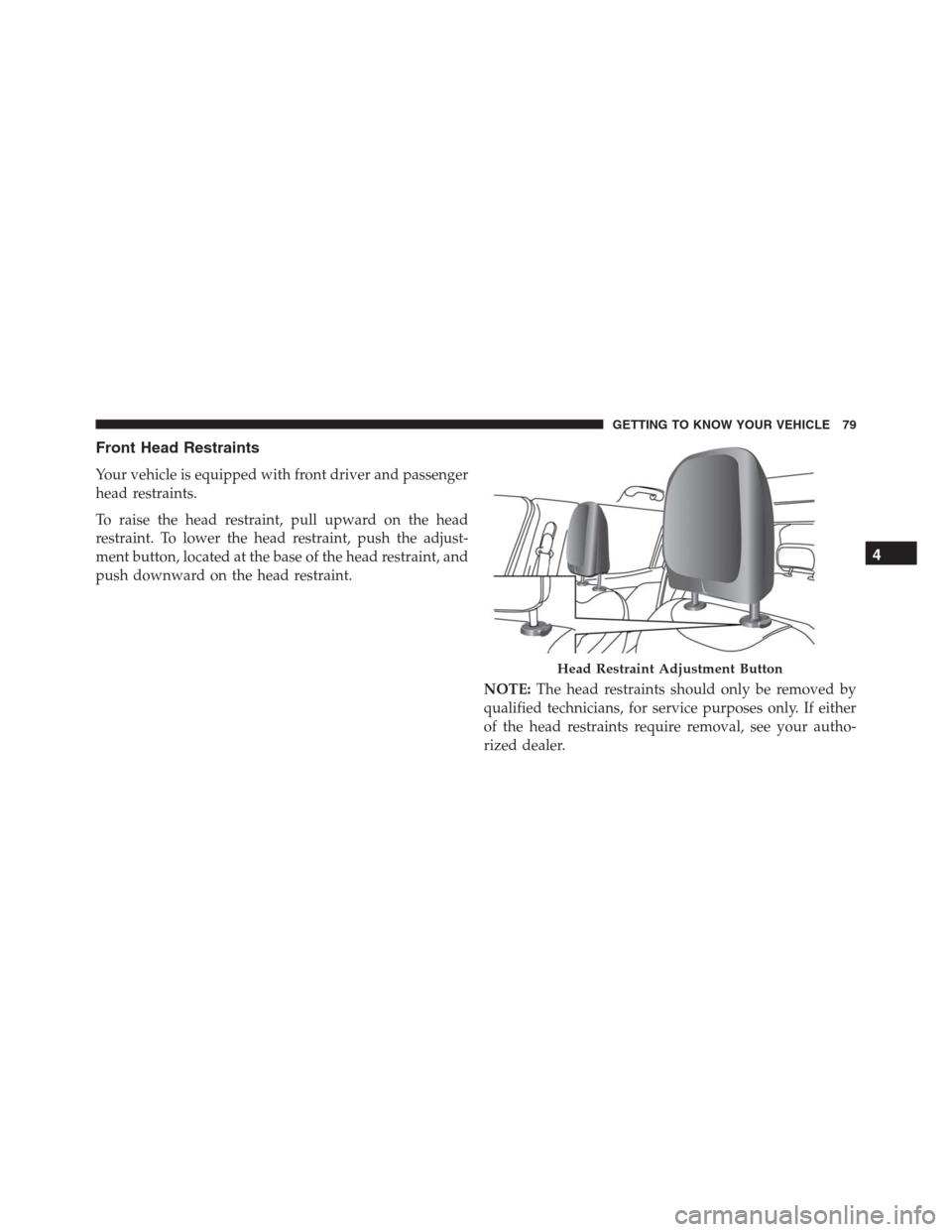
Front Head Restraints
Your vehicle is equipped with front driver and passenger
head restraints.
To raise the head restraint, pull upward on the head
restraint. To lower the head restraint, push the adjust-
ment button, located at the base of the head restraint, and
push downward on the head restraint.
NOTE:The head restraints should only be removed by
qualified technicians, for service purposes only. If either
of the head restraints require removal, see your autho-
rized dealer.
Head Restraint Adjustment Button
4
GETTING TO KNOW YOUR VEHICLE 79
Page 82 of 688
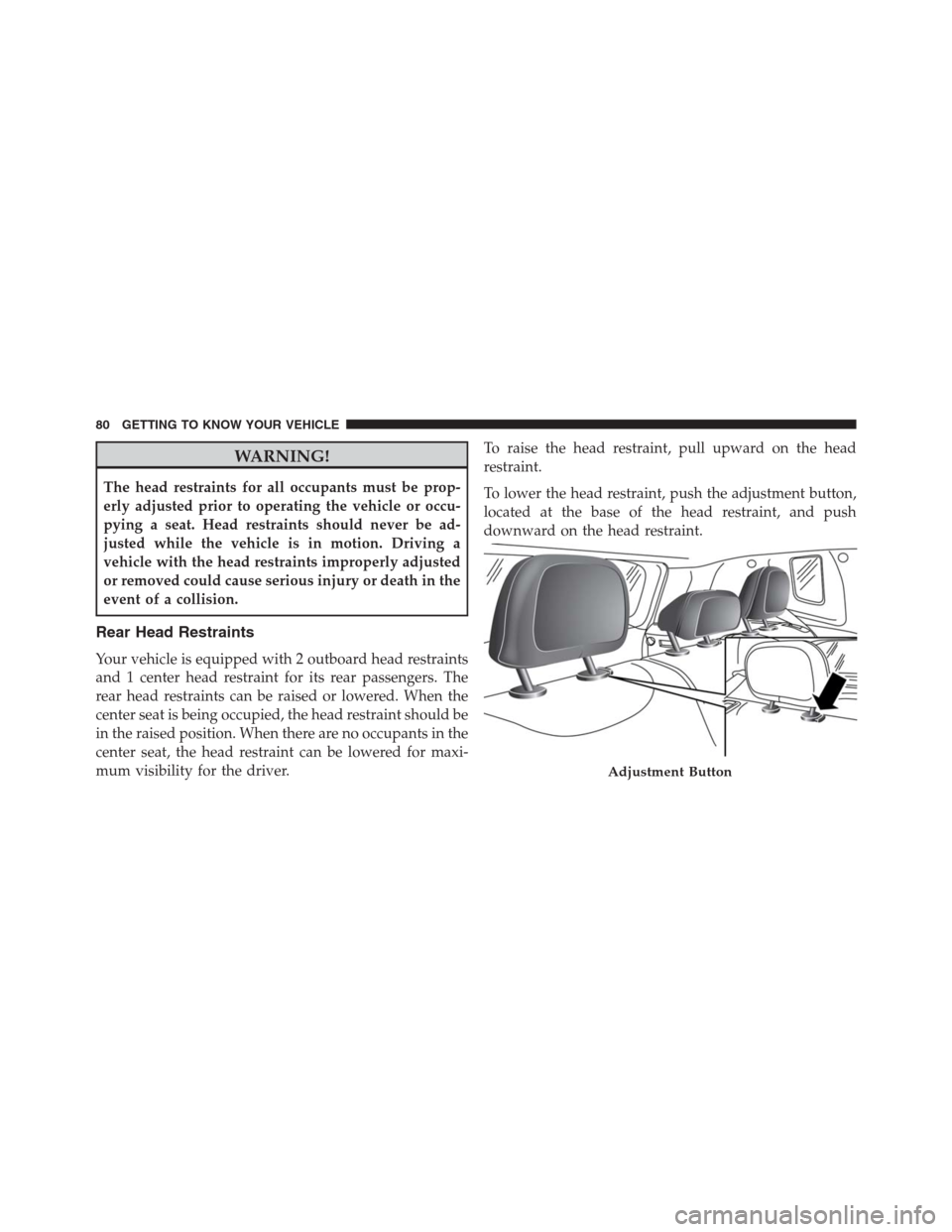
WARNING!
The head restraints for all occupants must be prop-
erly adjusted prior to operating the vehicle or occu-
pying a seat. Head restraints should never be ad-
justed while the vehicle is in motion. Driving a
vehicle with the head restraints improperly adjusted
or removed could cause serious injury or death in the
event of a collision.
Rear Head Restraints
Your vehicle is equipped with 2 outboard head restraints
and 1 center head restraint for its rear passengers. The
rear head restraints can be raised or lowered. When the
center seat is being occupied, the head restraint should be
in the raised position. When there are no occupants in the
center seat, the head restraint can be lowered for maxi-
mum visibility for the driver.To raise the head restraint, pull upward on the head
restraint.
To lower the head restraint, push the adjustment button,
located at the base of the head restraint, and push
downward on the head restraint.
Adjustment Button
80 GETTING TO KNOW YOUR VEHICLE
Page 83 of 688
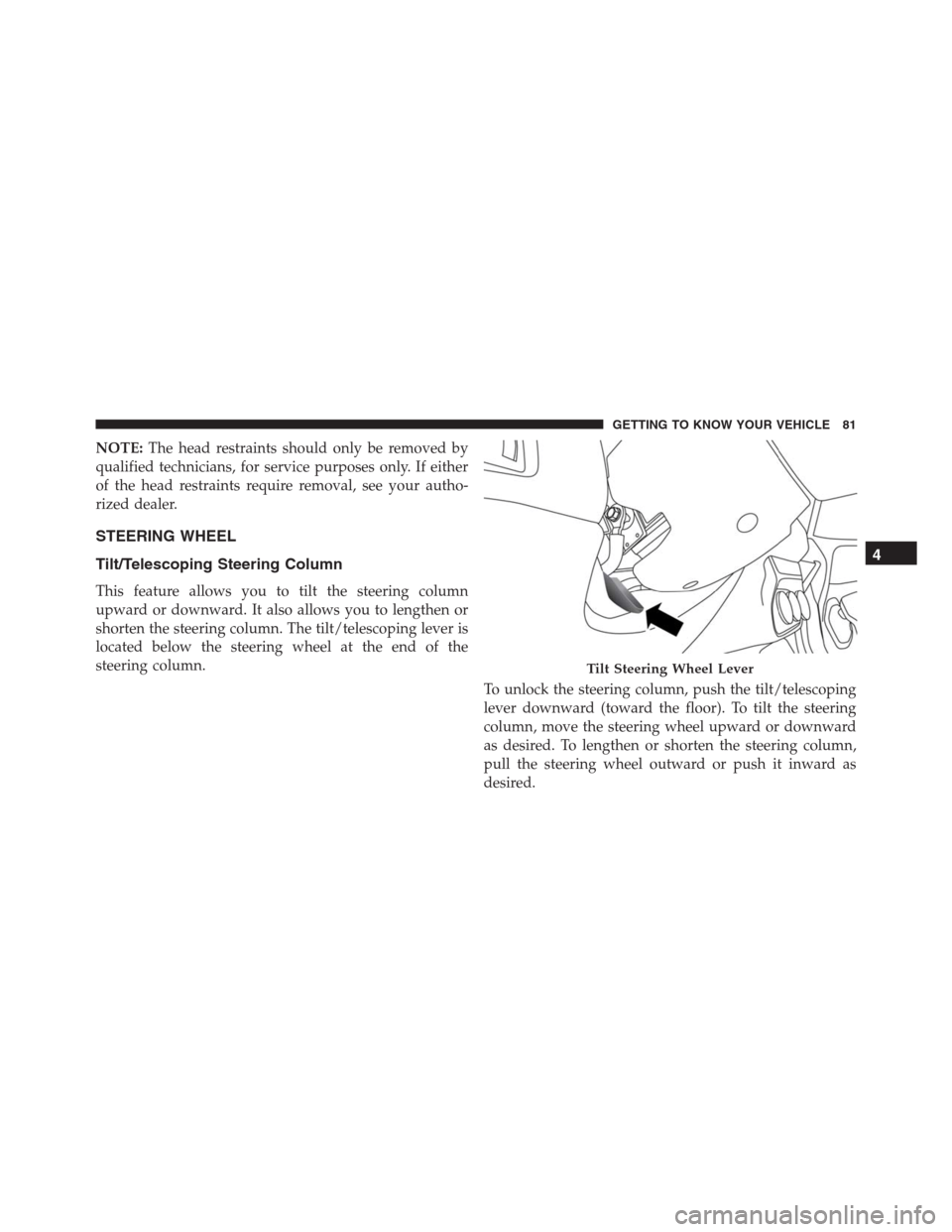
NOTE:The head restraints should only be removed by
qualified technicians, for service purposes only. If either
of the head restraints require removal, see your autho-
rized dealer.
STEERING WHEEL
Tilt/Telescoping Steering Column
This feature allows you to tilt the steering column
upward or downward. It also allows you to lengthen or
shorten the steering column. The tilt/telescoping lever is
located below the steering wheel at the end of the
steering column.
To unlock the steering column, push the tilt/telescoping
lever downward (toward the floor). To tilt the steering
column, move the steering wheel upward or downward
as desired. To lengthen or shorten the steering column,
pull the steering wheel outward or push it inward as
desired.
Tilt Steering Wheel Lever
4
GETTING TO KNOW YOUR VEHICLE 81
Page 84 of 688
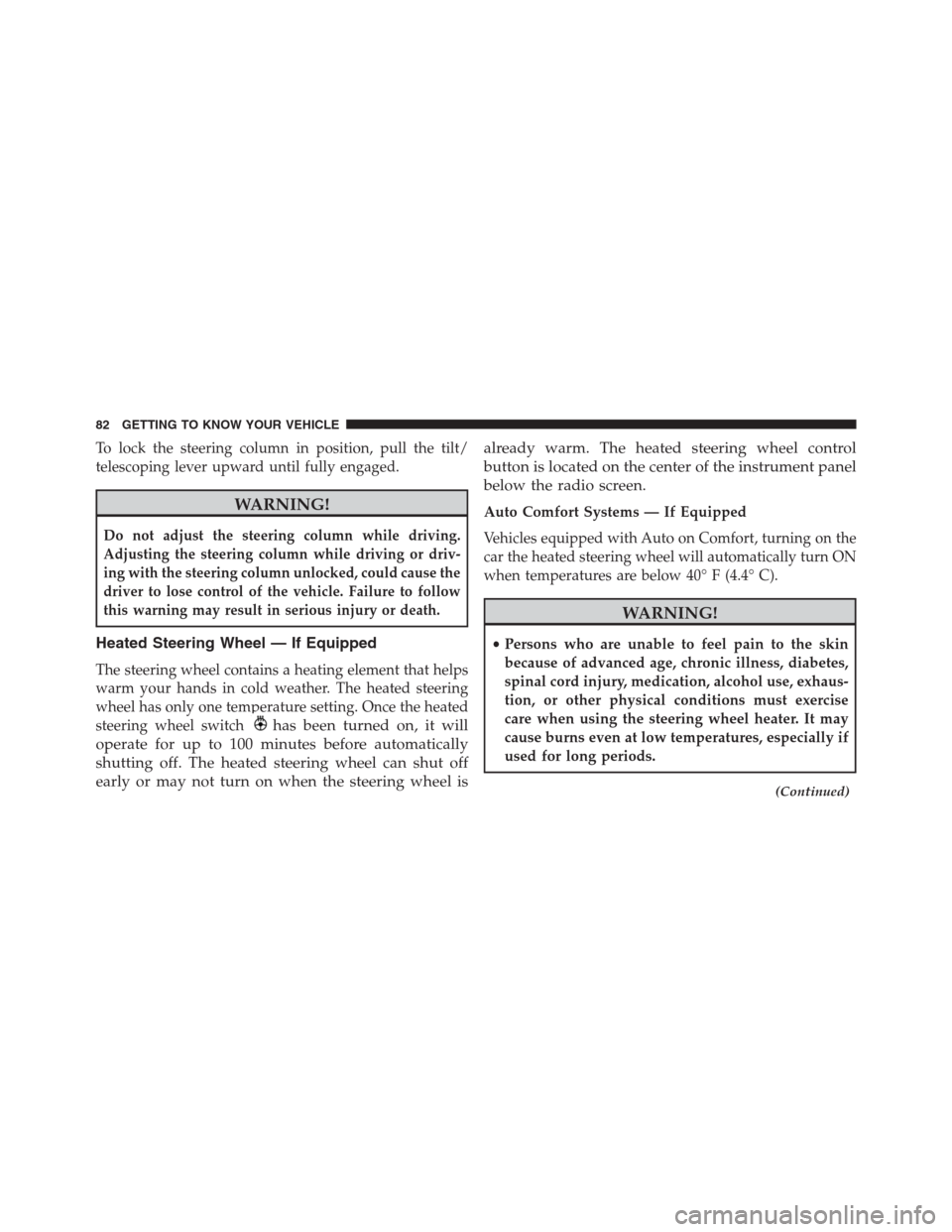
To lock the steering column in position, pull the tilt/
telescoping lever upward until fully engaged.
WARNING!
Do not adjust the steering column while driving.
Adjusting the steering column while driving or driv-
ing with the steering column unlocked, could cause the
driver to lose control of the vehicle. Failure to follow
this warning may result in serious injury or death.
Heated Steering Wheel — If Equipped
The steering wheel contains a heating element that helps
warm your hands in cold weather. The heated steering
wheel has only one temperature setting. Once the heated
steering wheel switch
has been turned on, it will
operate for up to 100 minutes before automatically
shutting off. The heated steering wheel can shut off
early or may not turn on when the steering wheel isalready warm. The heated steering wheel control
button is located on the center of the instrument panel
below the radio screen.
Auto Comfort Systems — If Equipped
Vehicles equipped with Auto on Comfort, turning on the
car the heated steering wheel will automatically turn ON
when temperatures are below 40° F (4.4° C).
WARNING!
•Persons who are unable to feel pain to the skin
because of advanced age, chronic illness, diabetes,
spinal cord injury, medication, alcohol use, exhaus-
tion, or other physical conditions must exercise
care when using the steering wheel heater. It may
cause burns even at low temperatures, especially if
used for long periods.
(Continued)
82 GETTING TO KNOW YOUR VEHICLE
Page 85 of 688
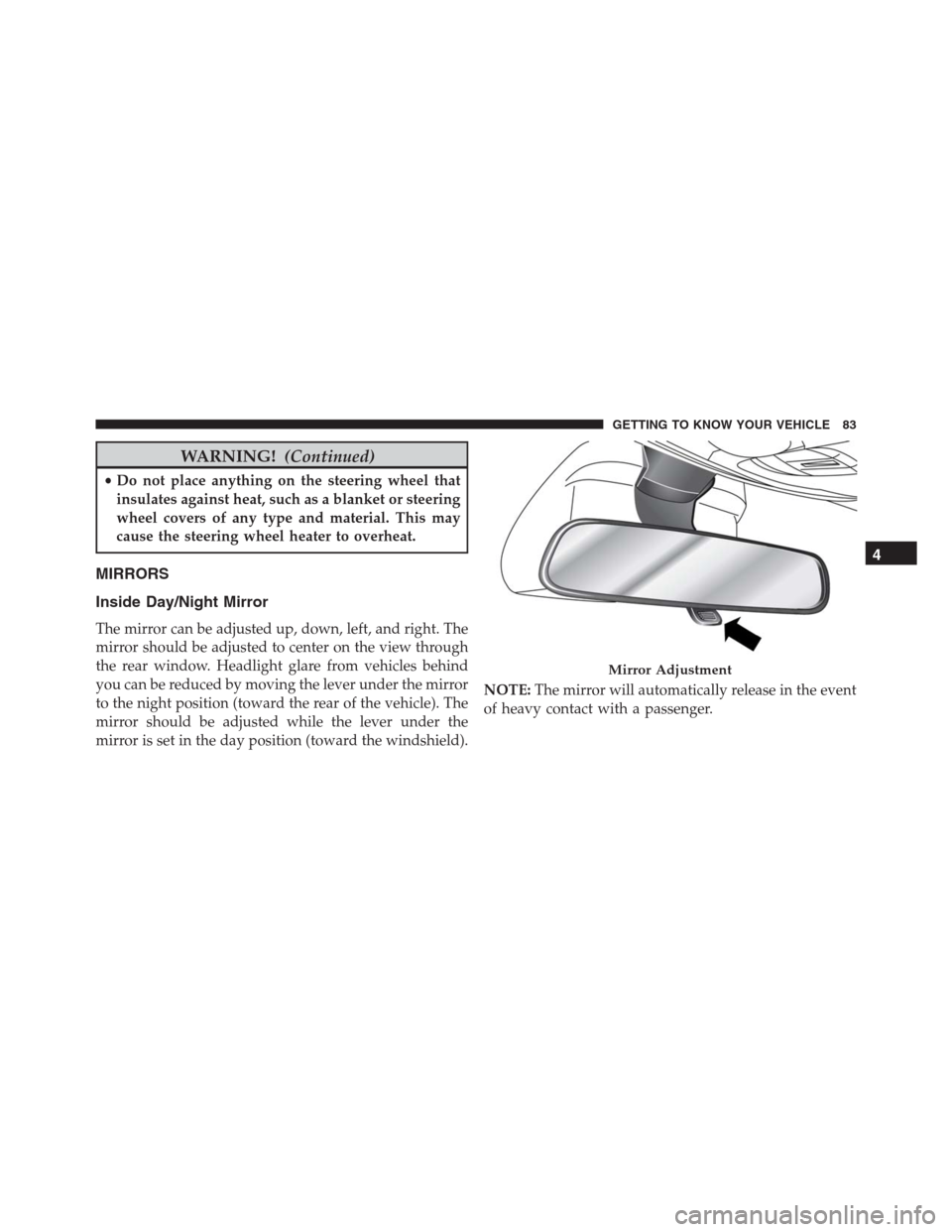
WARNING!(Continued)
•Do not place anything on the steering wheel that
insulates against heat, such as a blanket or steering
wheel covers of any type and material. This may
cause the steering wheel heater to overheat.
MIRRORS
Inside Day/Night Mirror
The mirror can be adjusted up, down, left, and right. The
mirror should be adjusted to center on the view through
the rear window. Headlight glare from vehicles behind
you can be reduced by moving the lever under the mirror
to the night position (toward the rear of the vehicle). The
mirror should be adjusted while the lever under the
mirror is set in the day position (toward the windshield).NOTE:The mirror will automatically release in the event
of heavy contact with a passenger.
Mirror Adjustment
4
GETTING TO KNOW YOUR VEHICLE 83
Page 86 of 688
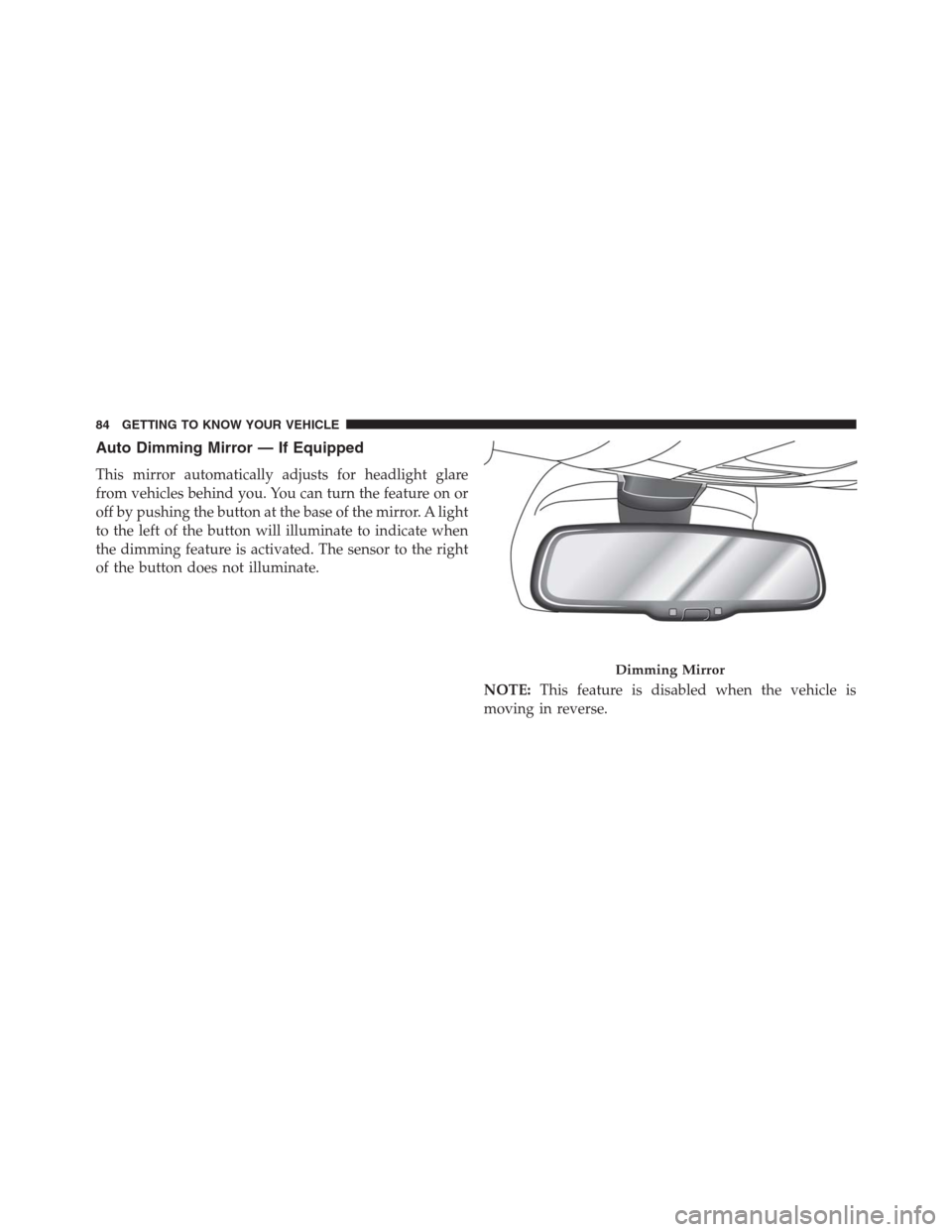
Auto Dimming Mirror — If Equipped
This mirror automatically adjusts for headlight glare
from vehicles behind you. You can turn the feature on or
off by pushing the button at the base of the mirror. A light
to the left of the button will illuminate to indicate when
the dimming feature is activated. The sensor to the right
of the button does not illuminate.
NOTE:This feature is disabled when the vehicle is
moving in reverse.
Dimming Mirror
84 GETTING TO KNOW YOUR VEHICLE
Page 87 of 688
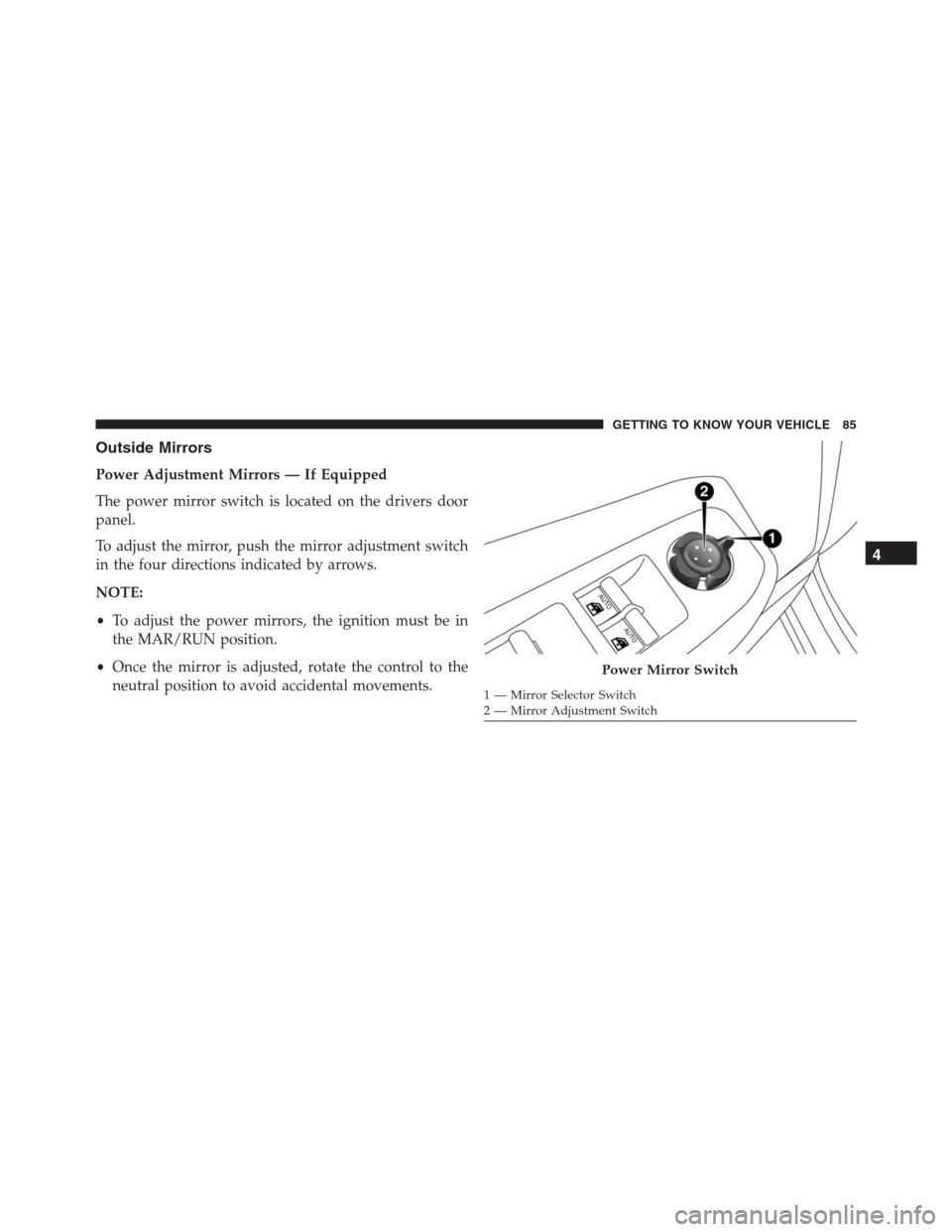
Outside Mirrors
Power Adjustment Mirrors — If Equipped
The power mirror switch is located on the drivers door
panel.
To adjust the mirror, push the mirror adjustment switch
in the four directions indicated by arrows.
NOTE:
•To adjust the power mirrors, the ignition must be in
the MAR/RUN position.
•Once the mirror is adjusted, rotate the control to the
neutral position to avoid accidental movements.
Power Mirror Switch
1 — Mirror Selector Switch
2 — Mirror Adjustment Switch
4
GETTING TO KNOW YOUR VEHICLE 85
Page 88 of 688
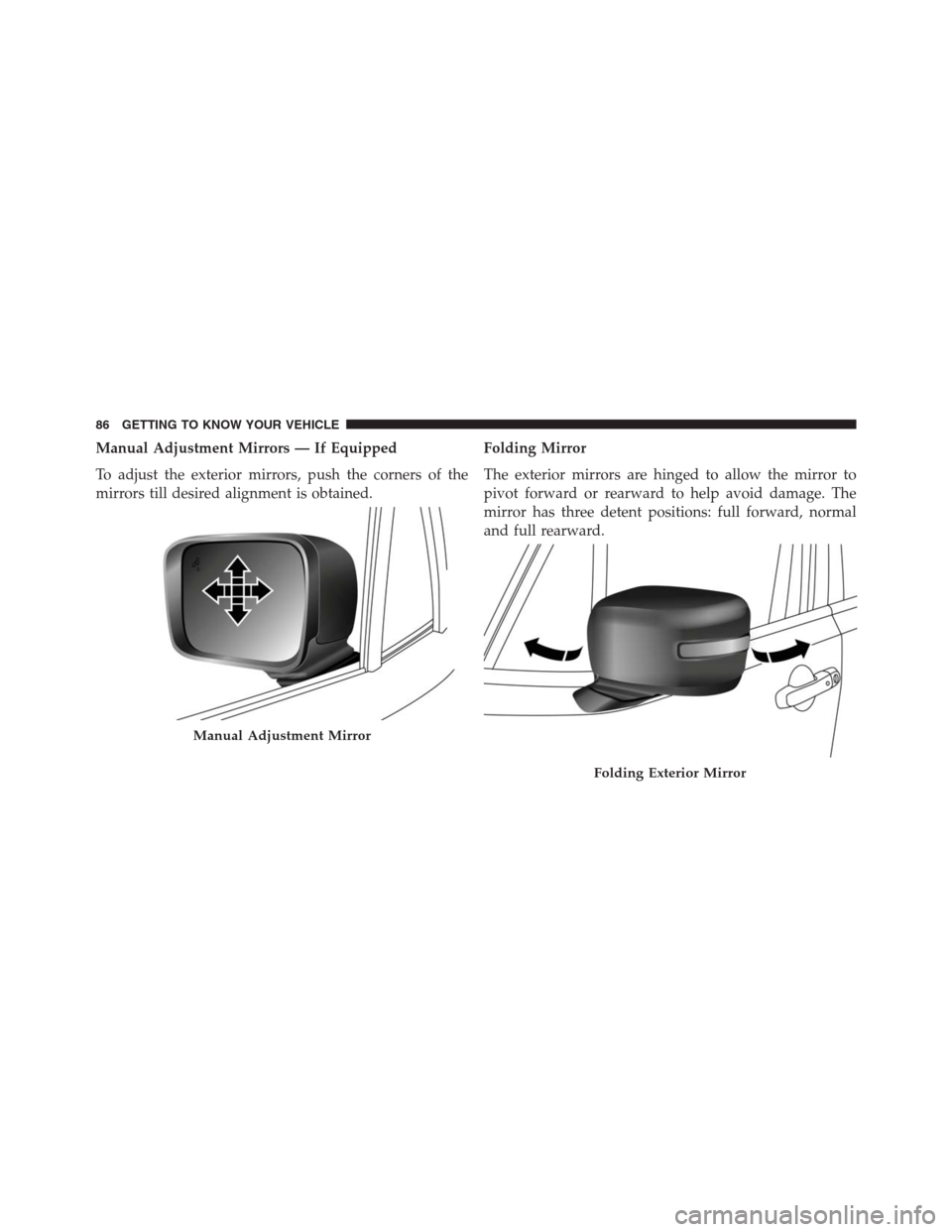
Manual Adjustment Mirrors — If Equipped
To adjust the exterior mirrors, push the corners of the
mirrors till desired alignment is obtained.Folding Mirror
The exterior mirrors are hinged to allow the mirror to
pivot forward or rearward to help avoid damage. The
mirror has three detent positions: full forward, normal
and full rearward.
Manual Adjustment Mirror
Folding Exterior Mirror
86 GETTING TO KNOW YOUR VEHICLE
Page 89 of 688
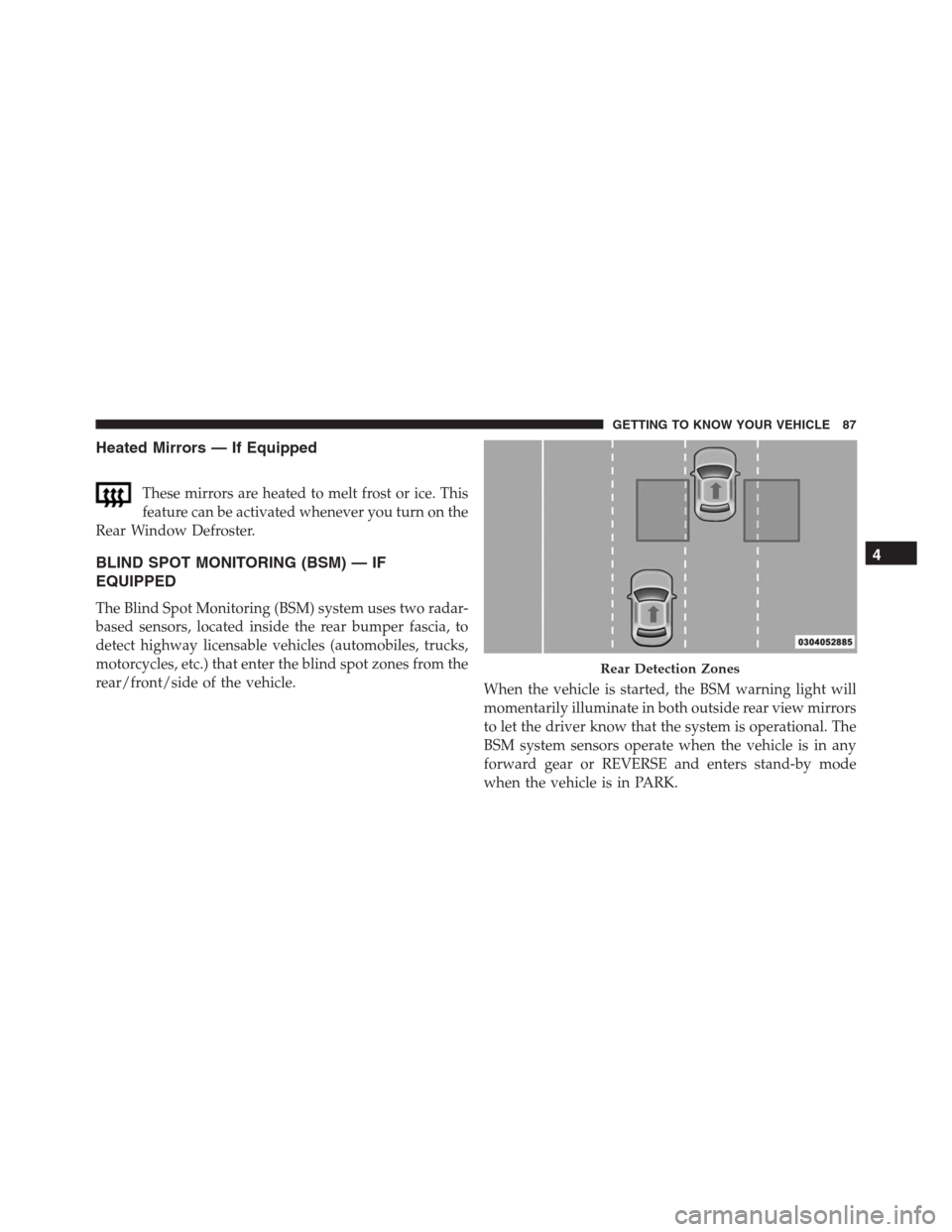
Heated Mirrors — If Equipped
These mirrors are heated to melt frost or ice. This
feature can be activated whenever you turn on the
Rear Window Defroster.
BLIND SPOT MONITORING (BSM) — IF
EQUIPPED
The Blind Spot Monitoring (BSM) system uses two radar-
based sensors, located inside the rear bumper fascia, to
detect highway licensable vehicles (automobiles, trucks,
motorcycles, etc.) that enter the blind spot zones from the
rear/front/side of the vehicle.
When the vehicle is started, the BSM warning light will
momentarily illuminate in both outside rear view mirrors
to let the driver know that the system is operational. The
BSM system sensors operate when the vehicle is in any
forward gear or REVERSE and enters stand-by mode
when the vehicle is in PARK.
Rear Detection Zones
4
GETTING TO KNOW YOUR VEHICLE 87
Page 90 of 688
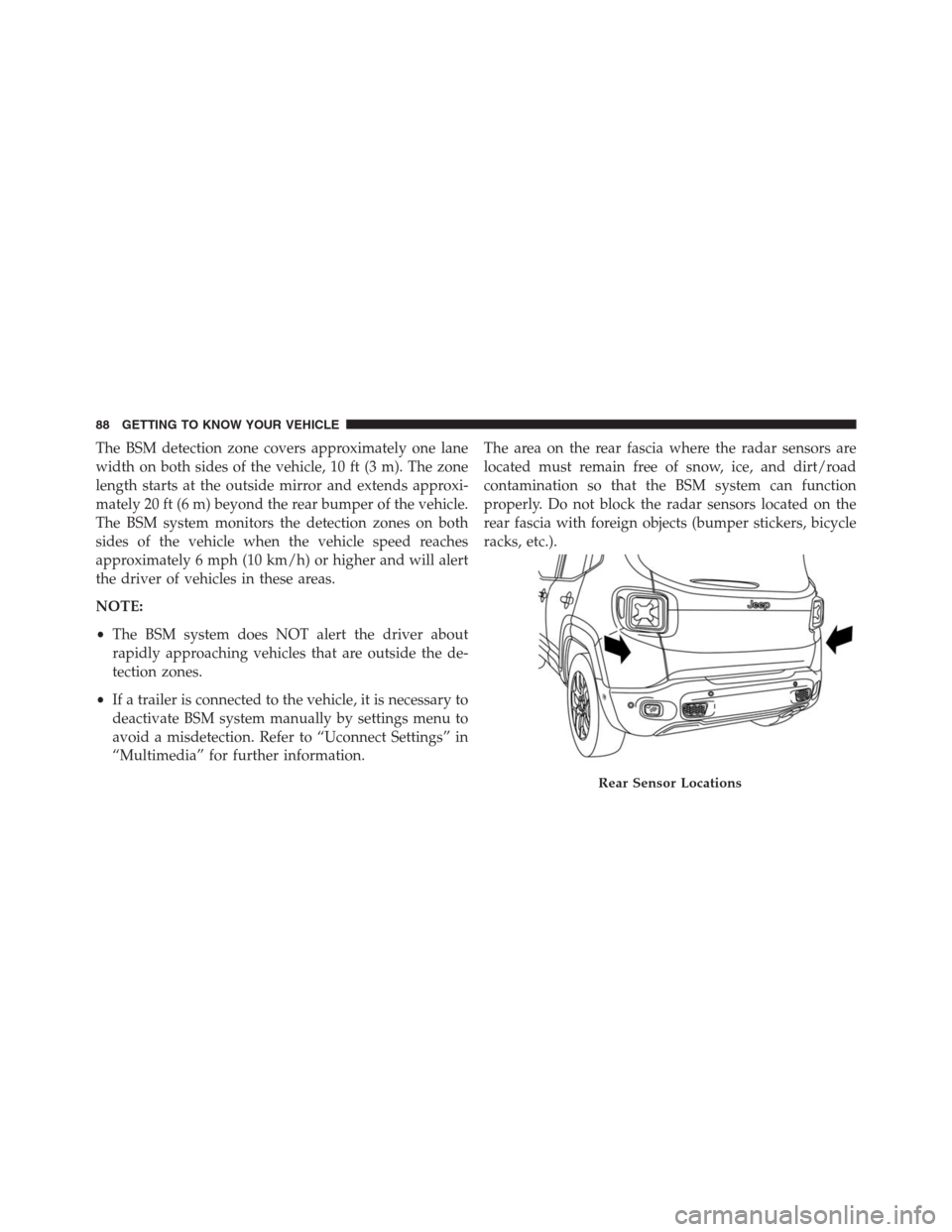
The BSM detection zone covers approximately one lane
width on both sides of the vehicle, 10 ft (3 m). The zone
length starts at the outside mirror and extends approxi-
mately 20 ft (6 m) beyond the rear bumper of the vehicle.
The BSM system monitors the detection zones on both
sides of the vehicle when the vehicle speed reaches
approximately 6 mph (10 km/h) or higher and will alert
the driver of vehicles in these areas.
NOTE:
•The BSM system does NOT alert the driver about
rapidly approaching vehicles that are outside the de-
tection zones.
•If a trailer is connected to the vehicle, it is necessary to
deactivate BSM system manually by settings menu to
avoid a misdetection. Refer to “Uconnect Settings” in
“Multimedia” for further information.The area on the rear fascia where the radar sensors are
located must remain free of snow, ice, and dirt/road
contamination so that the BSM system can function
properly. Do not block the radar sensors located on the
rear fascia with foreign objects (bumper stickers, bicycle
racks, etc.).
Rear Sensor Locations
88 GETTING TO KNOW YOUR VEHICLE